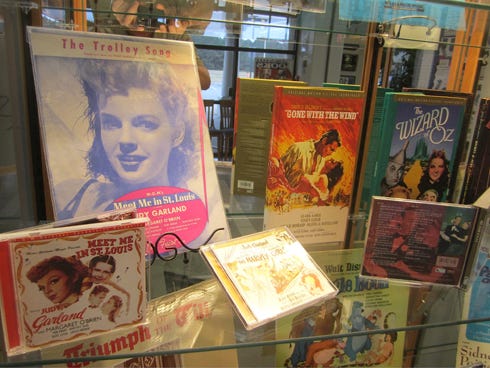
CRESTVIEW — What do the films “Goldfinger,” “Romeo and Juliet” and “Dead Ringer” have in common?
They’re among nearly 50 film soundtracks displayed in “The World of Movie Music,” an exhibit running through February in the Crestview Public Library’s lobby.
Exhibited items were culled from more than 2,500 soundtracks and cast albums in News Bulletin Arts and Entertainment Editor Brian Hughes’ collection. Before he came to Crestview, he co-founded and co-hosted “Stage and Screen,” a radio program of original musical theatre, film and TV music that began in 1986 and continues today on WTUL 91.5 FM in New Orleans.
Among displayed soundtracks are several well-known record labels sought by film music aficionados. These include soundtracks from classic MGM musicals “The Wizard of Oz,” “Gone With the Wind” and “Victor/Victoria,” remastered by Rhino Movie Music from original session tapes stored in studio vaults.
Early CD reissues of rare vinyl soundtracks released by the European Tsunami label are also exhibited. Composer Jerry Goldsmith’s classic soundtrack to “The Sand Pebbles” contrasts with a 2011 release on Intrada Records.
Other soundtracks — some issued for the first time, from original studio vault tapes — include limited-edition releases from FilmScore Monthly, namely “All About Eve” and Ron Goodwin’s much-sought-after complete score to the World War II Richard Burton and Clint Eastwood epic, “Where Eagles Dare.”
Two rarities are the soundtracks to Leni Riefenstahl documentaries.
The director produced “Triumph of the Will” for the Nazi Party in 1934. Especially rare is one of two proof soundtracks from her “Olympia,” a documentary of the 1936 Berlin Olympics produced for the International Olympic Committee.
Riefenstahl died at age 101 during early stages of production on the soundtrack CD and the project was abandoned.
Vinyl records, CDs, reel-to-reel tapes, cassettes and 8-track tapes are among the collection.
Sheet music, including a rare copy of “The Trolley Song” that Judy Garland sang in “Meet Me in St. Louis,” also is exhibited.
Informational tags discuss soundtrack collecting and offer tips on identifying an original soundtrack recording versus a studiotrack.
The former is the actual music recorded for and heard in the film.
A studiotrack is a subsequent recording, sometimes by an artist not connected with the film, and other times by the composer who returns to the studio to make a second recording of his score to enhance the music for the album.
Most of Henry Mancini’s “soundtracks” are, in fact, studiotracks.
From John Barry to John Williams, Max Steiner to Ennio Morricone, some of film music composition’s most renowned names are represented through February in the lobby display cases of the Crestview Public Library.
This article originally appeared on Crestview News Bulletin: Soundtrack exhibit currently mounted at Crestview library
